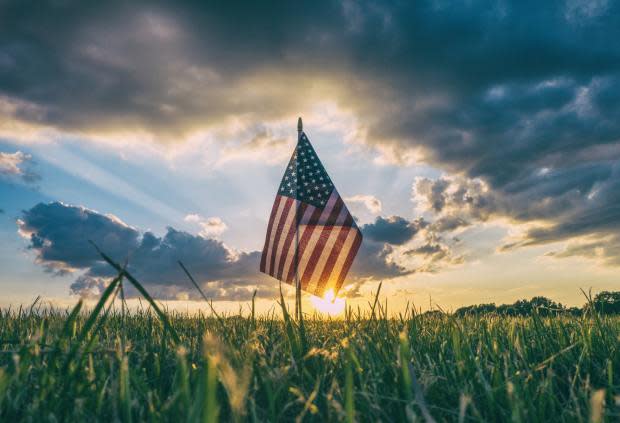Looking Ahead to the Holiday Weekend—When Is Labor Day in 2023 and What Does It Mean?

Labor Day is known as one of the handful of Monday holidays that give us a delightful three-day weekend if we get the day off. Throughout the years, this holiday has become synonymous with family barbecues, soaking up those final moments of summer and, of course, Labor Day sales.
But there's more to Labor Day than just snagging a discounted mattress or grilling burgers. In fact, the origins of Labor Day stretch all the way back to 1882 and believe it or not, it all started with a parade.
Ready to brush up on your Labor Day facts? Keep reading for a breakdown on the holiday weekend—from when LDW falls this year to why we celebrate and more.
Related: September Holidays and Observances
When is Labor Day 2023?
Labor Day is a national holiday that always falls on the first Monday in September. As such, it gives (most) workers a three-day weekend off from work, which is why it's often referred to as Labor Day Weekend or when abbreviated, LDW.
This year, Labor Day 2023 is on Monday, September 4.
Related: Delicious Summer Side Dishes
Does Labor Day change every year?
Every year, Labor Day falls on the first Monday of September, which means that the date does change each year. For example, last year Labor Day was Monday, September 5. This year, Labor Day is Monday, September 4.
The next five Labor Day dates will be:
Monday, September 2, 2024
Monday, September 1, 2025
Monday, September 7, 2026
Monday, September 6, 2027
Monday, September 4, 2028
Is Labor Day a national holiday?
Labor Day is, in fact, a national holiday, which means it's recognized federally. As one of the most common paid holidays in the U.S., Business News Daily found that 97 percent of employers provide time off to at least some of their employees in observance of Labor Day.
Still, as many as 40 percent of businesses will remain open.
Related: Boozy Cocktail Drinks That Work From Memorial Day to Labor Day
So, who doesn't get Labor Day off? Typically, police and correctional officers, certain utilities workers and operators, air traffic controllers, registered nurses, firefighters, those in retail, and those in major transportation services don't get the day off.

Unsplash
Why do we celebrate Labor Day?
You may be wondering why Labor Day is a national holiday and therefore, why we celebrate it. The first-ever Labor Day happened on September 5, 1882 (in fact, 2021 marked the 125th anniversary of LDW) and began when members of New York’s Central Labor Union marched in protest of unsafe work conditions, but also to honor the benefits of the union. Approximately 10,000 workers marched from City Hall to 42nd Street in New York City.
It took three more years for Labor Day celebrations to spread to other major metropolitan areas.
According to the U.S. Department of Labor, 23 more states were recognizing Labor Day by 1894. That same year, President Grover Cleveland signed Labor Day into law, officially declaring the first Monday of every September the national holiday we know it to be today.
Related: Everything You Need to Know About the Growing Sport of Pickleball
To this day, America celebrates the holiday weekend as a way to "recognize the many contributions workers have made to America's strength, prosperity, and well-being," as the Department of Labor puts it.
What does Labor Day mean?
Labor Day first began as a protest—a "parade" of sorts, which is why it is still often marked by parades today. But it's not just a day away from the office for many hard-working Americans. Sure, it's often looked at as the unofficial closing of summer, but really the meaning behind Labor Day is much more.
To understand the meaning of Labor Day, it's important to put into context the unsafe and often cruel working conditions of the times. While a lot of positives came from America's Industrial Revolution during the 18th and 19th centuries, the working conditions and expectations of workers were far from fair, safe, and in many cases, even humane.
Related: Best Songs of Summer—Ranked
Many employees did a significant amount of work for an insignificant amount of pay. In fact, workers were often expected to work 12-hour work days with no weekends off even. To add insult to injury, many young children also worked during this time—again, in unsafe conditions and for little monetary payoff.
There were no unions mobilized, no Human Resources established yet—no one to regulate fair pay, reasonable hours, and other important tenants of fairness and safety that are much more common in the workplace today.
Related: Best Books to Read This Summer
While we know for sure that Labor Day originated in New York City in 1882 and became an official national holiday by 1894, history buffs often go back and forth as to whose idea Labor Day truly was.
According to History.com, "Many credit Peter J. McGuire, co-founder of the American Federation of Labor, while others have suggested that Matthew Maguire, a secretary of the Central Labor Union, first proposed the holiday."
How is Labor Day different from May Day?
May Day takes place on May 1 every year and is known as International Workers' Day. It, too, pays homage to the workforce. Similar to Labor Day, May Day also developed from workers' desire for an eight-hour workday.
However, May Day is not recognized as a national holiday in the U.S. More than 66 countries throughout the world do recognize it as an official holiday, but Americans typically don't get May 1 off from work.
Related: Easy Labor Day Grilling Recipes
Facts about Labor Day
President Cleveland signed Labor Day into national holiday status in 1894 but this triumph for workers everywhere became so largely in part due to tragedy.
During what became known as the Pullman Strike, President Cleveland sent troops and U.S. Marshals to deal with the 125,000 railroad workers on strike. Ultimately, 13 workers were killed and 60 were injured as a result. Soon after, Cleveland declared Labor Day a federal holiday with many interpreting his intentions to be purely political.
Related: Fun Outdoor Games for Kids
Despite Cleveland declaring Labor Day a national holiday in 1894, railroad workers didn't really reap its benefits until 1916 when President Woodrow Wilson signed the Adamson Act. According to the National Employment Law Project, the Adamson Act officially made an eight-hour workday the legal standard.
Related: Back-to-School Party Ideas
It's also true that Canada did it first. While the U.S. didn't conceive of Labor Day until 1882, Canada started addressing the needs and rights of workers almost a decade prior.
From January through June 1872, Canadian workers campaigned for shortened work days. It became known as the Nine Hour Movement and arguably, walked so that the Canadian Labor Union could run.
Find out more interesting Labor Day facts here.

Unsplash
How to celebrate Labor Day
Many workers celebrate the Labor Day three-day weekend by spending their Monday off work however they like. Still, Labor Day has created some traditions of its own.
As the unofficial end to summer, Labor Day is often spent barbecuing, grilling, hanging by the pool or at the beach, or by lighting fireworks. Many households also choose to travel for LDW. After all, it's usually the last chance to hit the beach before the temps start to cool down.
Related: Best Fall Candles to Burn in Your Home for Coziness
Of course, Labor Day is often celebrated in a similar fashion to how it started: a parade. Though the first one was a protest of sorts, cities and towns all across the U.S. still commemorate the weekend with parades and festivals that honor workers' many contributions today.
Lastly, Labor Day is also sometimes seen as the final time to wear white during the calendar year (that is, until the following May). While many people no longer choose to adhere to this antiquated style rule, some still abide by it and use Labor Day Weekend to pack away their white denim for the colder months.
